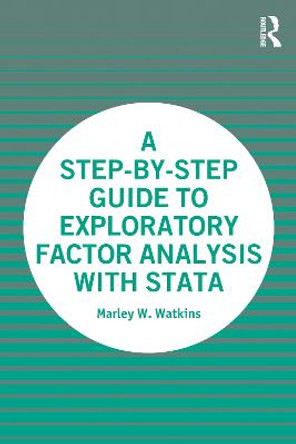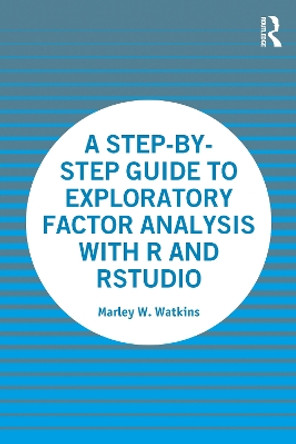Description
This is a concise, easy to use, step-by-step guide for applied researchers conducting exploratory factor analysis (EFA) using SPSS.
In this book, Dr. Watkins systematically reviews each decision step in EFA with screen shots and code from SPSS and recommends evidence-based best-practice procedures. This is an eminently applied, practical approach with few or no formulas and is aimed at readers with little to no mathematical background. Dr. Watkins maintains an accessible tone throughout and uses minimal jargon to help facilitate grasp of the key issues users will face while applying EFA, along with how to implement, interpret, and report results. Copious scholarly references and quotations are included to support the reader in responding to editorial reviews.
This is a valuable resource for upper-level undergraduate and postgraduate students, as well as for more experienced researchers undertaking multivariate or structure equation modeling courses across the behavioral, medical, and social sciences.
About the Author
Marley W. Watkins earned a Ph.D. in Educational Psychology and Measurements with a specialty in School Psychology from the University of Nebraska-Lincoln, USA. He is currently Research Professor in the Department of Educational Psychology at Baylor University, USA, and has authored more than 200 articles, books, and chapters and presented more than 150 papers at professional conferences.
Reviews
"This book is an important contribution to the field. I have been publishing articles using EFA for over 30 years, yet it provided me with new insights and information on EFA. More importantly, the material is easy to follow and accessible to researchers and graduate students new to EFA. I highly recommend it to anyone seeking to become competent in EFA." - Joseph J. Glutting, University of Delaware, USA
"This book provides a remarkably clear and detailed presentation of best practices in exploratory factor analysis (EFA) that will be of tremendous help to those first learning to understand and conduct EFA and also a great resource for already using EFA or teaching its use. Its well organized and sequenced presentation of historical development and contemporary use, including annotated descriptions and illustrations, and sample data sets for practice, are invaluable for instruction or self-guided learning. As one who routinely conducts EFA using SPSS I have welcomed Dr. Watkins' creation and free distribution of standalone software to conduct various analyses related to EFA that are not available in SPSS (although they should be) and examples of their use (as well as other applications or SPSS syntax published in the literature) are indispensable resources. I cannot recommend this book more highly!" - Gary L. Canivez, Eastern Illinois University, USA
"A Step-by-Step Guide to Exploratory Factor Analysis with SPSS offers not only an explanation of how to use the SPSS syntax but also a clear overview of how to conduct an EFA. It is a valuable resource for students and researchers alike." - Stefan C. Dombrowski, Rider University, USA
"This is by far, the best book of its kind. Professor Watkins has an accessible and engaging writing style that nicely blends underlying theoretical assumptions of exploratory factor analysis with easy-to-follow, practical suggestions for the statistical calculations. This text will be a tremendous resource for beginning, intermediate, and advanced researchers. Highly recommended!" - Joseph C. Kush, Duquesne University, USA
"This book is an important contribution to the field. I have been publishing articles using EFA for over 30 years, yet it provided me with new insights and information on EFA. More importantly, the material is easy to follow and accessible to researchers and graduate students new to EFA. I highly recommend it to anyone seeking to become competent in EFA."
Joseph J. Glutting, University of Delaware, USA
"This book provides a remarkably clear and detailed presentation of best practices in exploratory factor analysis (EFA) that will be of tremendous help to those first learning to understand and conduct EFA and also a great resource for already using EFA or teaching its use. Its well organized and sequenced presentation of historical development and contemporary use, including annotated descriptions and illustrations, and sample data sets for practice, are invaluable for instruction or self-guided learning. As one who routinely conducts EFA using SPSS I have welcomed Dr. Watkins' creation and free distribution of standalone software to conduct various analyses related to EFA that are not available in SPSS (although they should be) and examples of their use (as well as other applications or SPSS syntax published in the literature) are indispensable resources. I cannot recommend this book more highly!"
Gary L. Canivez, Eastern Illinois University, USA
"A Step-by-Step Guide to Exploratory Factor Analysis with SPSS offers not only an explanation of how to use the SPSS syntax but also a clear overview of how to conduct an EFA. It is a valuable resource for students and researchers alike."
Stefan C. Dombrowski, Rider University, USA
"This is by far, the best book of its kind. Professor Watkins has an accessible and engaging writing style that nicely blends underlying theoretical assumptions of exploratory factor analysis with easy-to-follow, practical suggestions for the statistical calculations. This text will be a tremendous resource for beginning, intermediate, and advanced researchers. Highly recommended!"
Joseph C. Kush, Duquesne University, USA
Book Information
ISBN 9780367710316
Author Marley W. Watkins
Format Paperback
Page Count 204
Imprint Routledge
Publisher Taylor & Francis Ltd
Weight(grams) 410g




